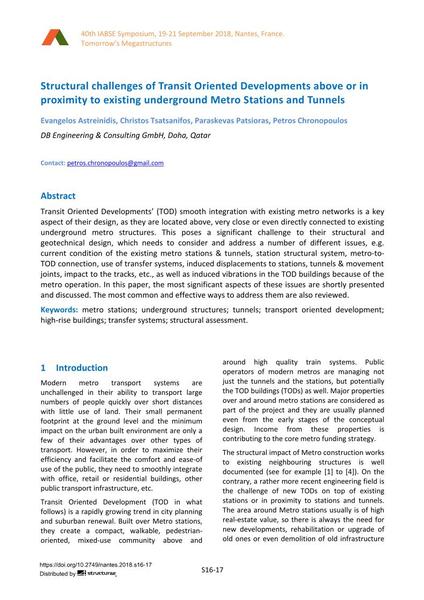Structural challenges of Transit Oriented Developments above or in proximity to existing underground Metro Stations and Tunnels

|
|
|||||||||||
Bibliographic Details
| Author(s): |
Evangelos Astreinidis
(DB Engineering & Consulting GmbH, Doha, Qatar)
Christos Tsatsanifos (DB Engineering & Consulting GmbH, Doha, Qatar) Paraskevas Patsioras (DB Engineering & Consulting GmbH, Doha, Qatar) Petros Chronopoulos (DB Engineering & Consulting GmbH, Doha, Qatar) |
||||
|---|---|---|---|---|---|
| Medium: | conference paper | ||||
| Language(s): | English | ||||
| Conference: | IABSE Symposium: Tomorrow’s Megastructures, Nantes, France, 19-21 September 2018 | ||||
| Published in: | IABSE Symposium Nantes 2018 | ||||
|
|||||
| Page(s): | S16-17 | ||||
| Total no. of pages: | 8 | ||||
| DOI: | 10.2749/nantes.2018.s16-17 | ||||
| Abstract: |
Transit Oriented Developments’ (TOD) smooth integration with existing metro networks is a key aspect of their design, as they are located above, very close or even directly connected to existing underground metro structures. This poses a significant challenge to their structural and geotechnical design, which needs to consider and address a number of different issues, e.g. current condition of the existing metro stations & tunnels, station structural system, metro-to- TOD connection, use of transfer systems, induced displacements to stations, tunnels & movement joints, impact to the tracks, etc., as well as induced vibrations in the TOD buildings because of the metro operation. In this paper, the most significant aspects of these issues are shortly presented and discussed. The most common and effective ways to address them are also reviewed. |
||||
| Keywords: |
structural assessment high-rise buildings underground structures metro stations tunnel transport oriented development transfer systems
|
||||
